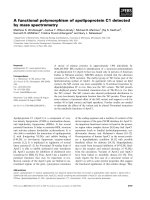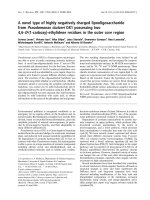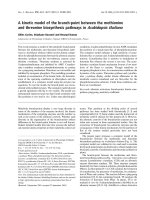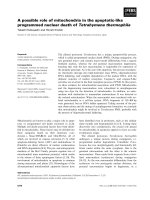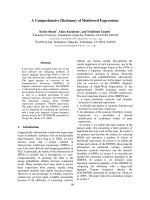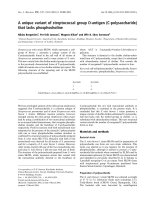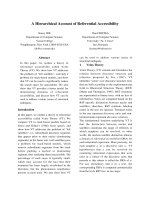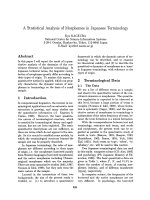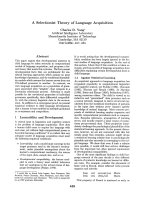Báo cáo khoa học: "A Practical Comparison of Parsing Strategies" docx
Bạn đang xem bản rút gọn của tài liệu. Xem và tải ngay bản đầy đủ của tài liệu tại đây (708.42 KB, 6 trang )
A Practical Comparison of Parsing Strategies
Jonathan Slocum
Siemens Corporation
INTRODUCTION
Although the literature dealing with formal and natural
languages abounds with theoretical arguments of worst-
case performance by various parsing strategies [e.g.,
Griffiths & Petrick, 1965; Aho & Ullman, 1972; Graham,
Harrison & Ruzzo, Ig80], there is little discussion of
comparative performance based on actual practice in
understanding natural language. Yet important practical
considerations do arise when writing programs to under-
stand one aspect or another of natural language utteran-
ces. Where, for example, a theorist will characterize a
parsing strategy according to its space and/or time
requirements in attempting to analyze the worst possible
input acc3rding to ~n arbitrary grammar strictly limited
in expressive power, the researcher studying Natural
Language Processing can be justified in concerning
himself more with issues of practical performance in
parsing sentences encountered in language as humans
Actually use it using a grammar expressed in a form
corve~ie: to the human linguist who is writing it.
Moreover, ~ry occasional poor performance may be quite
acceptabl:, particularly if real-time considerations are
not invo~ed, e.g., if a human querant is not waiting
for the answer to his question), provided the overall
average performance is superior. One example of such a
situation is off-line Machine Translation.
This paper has two purposes. One is to report an eval-
uation of the performance of several parsing strategies
in a real-world setting, pointing out practical problems
in making the attempt, indicating which of the strate-
gies is superior to the others in which situations, and
most of all determining the reasons why the best strate-
gy outclasses its competition in order to stimulate and
direct the design of improvements. The other, more
important purpose is to assist in establishing such
evaluation as a meaningful and valuable enterprise that
contributes to the evolution of Natural Language
PrcJessing from an art form into an empirical science.
T~t is, our concern for parsing efficiency transcends
the issue of mere practicality. At slow-to-average
parsing rates, the cost of verifying linguistic theories
on a large, general sample of natural language can still
be prohibitive. The author's experience in MT has
demonstrated the
enormous
impetus to linguistic theory
formulation and refinement that a suitably fast parser
will impart: when a linguist can formalize and encode a
theory, then within an hour test it on a few thousand
words of natural text, he will be able to reject
inadequate ideas at a fairly high rate. This argument
may even be applied to the production of the semantic
theory we all hope for: it is not likely that its early
formulations will be adequate, and unless they can be
explored inexpensively on significant language samples
they may hardly be explored at all, perhaps to the
extent that the theory's qualities remain undiscovered.
The search for an optimal natural language parsing
technique, then, can be seen as the search for an
instrument to assist in extending the theoretical
frontiers of the science of Natural Language Processing.
Following an outline below of some of the historical
circumstances that led the author to design and conduct
the parsing experiments, we will detail our experimental
setting and approach, present the results, discuss the
implications of those results, and conclude with some
remarks on what has been l~rned.
The SRI Connection
At SRI International the~thor was responsible for the
development of the English front-end for the LADDER
system [Hendrix etal., 1978]. LADDER was developed as
a prototype system for understanding questions posed in
English about a naval domain; it translated each English
question into one or more relational database queries,
prosecuted the queries on a remote computer, and
responded with the requested information in a readable
format tailored to the characteristics of the answer.
The basis for the development of the NLP component of
the LADDER system was the LIFER parser, which
interpreted sentences according to a 'semantic grammar'
[Burton, 1976] whose rules were carefully ordered to
produce the most plausible interpretation first.
After more than two years of intensive development, the
human costs of extending the coverage began to mount
significantly. The semantic grammar interpreted by
LIFER had become large and unwieldy. Any change,
however small, had the potential to produce "ripple
effects" which eroded the integrity of the system. A
more linguistically motivated grammar was required. The
question arose, "Is LIFER as suited to more traditional
grammars as it is to semantic grammars?" At the time,
there were available at SRI three production-quality
parsers: LIFER; DIAMOND, an implementation of the Cocke-
Kasami~nger parsing algorithm programmed by William
Paxton of SRI; and CKY, an implementation of the
identical algorithm programmed initially by Prof. Daniel
Chester at the University of Texas. In this
environment, experiments comparing various aspects of
performance were inevitable.
The LRC Connection
In 1979 the author began research in Machine Translation
at the Linguistics Research Center of the University of
Texas. The LRC environment stimulated the design of a
new strategy variation, though in retrospect it is
obviously applicable to any parser supporting a facility
for testing right-hand-side rule constituents. It also
stimulated the production of another parser. (These
will be defined and discussed later.) To test the
effects of various strategies on the two LRC parsers, an
experiment was designed to determine whether they
interact with the different parsers and/or each other,
whether any gains are offset by introduced overhead,
and whether the source and precise effects of any
overhead could be identified and explained.
THE SRI EXPERIMENTS
In this section we report the experiments conducted at
SRI. First, the parsers and their strategy variations
are described and intuitively compared; second, the
grammars are described in terms of their purpose and
their coverage; third, the sentences employed in the
comparisons are discussed with regard to their source
and presumed generality; next, the methods of comparing
performance are detailed; then the results of the major
experiment are presented. Finally, three small follow-
up experiments are reported as anecdotal evidence.
The Parsers and Strategies
One of the parsers employed in the SRI experiments was
LIFER: a top-down, depth-first parser with automatic
back-up [Hendrix, 1977]. LIFER employs special "look
down" logic based on the current word in the sentence to
eliminate obviously fruitless downward expansion when
the current word cannot be accepted as the leftmose
element in any expansion of the currently proposed
syntactic category [Griffiths and Petrick, 1965] and a
"well-formed substring table" [Woods, 1975] to eliminate
redundant pursuit of paths after back-up. LIFER sup-
ports a traditional style of rule writing where phrase-
structure rules are augmented by (LISP) procedures which
can reject the application of the rule when proposed by
the parser, and which construct an interpretation of the
phrase when the rule's application is acceptable. The
special user-definable routine responsible for
evaluating the S-level rule-body procedures was modified
to collect certain statistics but reject an otherwise
acceptable interpretation; this forced LIFER into its
back-up mode where it sought out an alternate
interpretation, which was recorded and rejected in the
same fashion. In this way LIFER proceeded to derive all
possible interpretations of each sentence according to
the grammar. This rejection behavior was not entirely
unusual, in that LIFER specifically provides for such an
eventuality, and because the grammars themselves were
already making use of this facility to reject faulty
interpretations. By forcing LIFER to compute all
interpretations in this natural manner, it could
meaningfully be compared with the other parsers.
The second parser employed,in the 5RI experiments was
DIAMOND: an all-paths bottom-up parser [Paxton, lg77]
developed at SRI as an outgrowth of the SRI Speech
Understanding Project [Walker, 1978]. The basis of the
implementation was the Cocke-Kasami-Younger algorithm
[Aho and Ullman, 1972], augmented by an "oracle" [Pratt,
1975] to restrict the number of syntax rules considered.
DIAMOND is used during the primarily syntactic,
bottom-up phase of analysis; subsequent analysis phases
work top-down through the parse tree, computing more
detailed semantic information, but these do not involve
DIAMOND per se. DIAMOND also supports a style of rules
wherein the grammar is augmented by LISP procedures to
either reject rule application, or compute an
interpretation of the phrase.
The third parser used in the SR~ experiments is dubbed
CKY. It too is an i~lementation of the Cocke-Kasami-
Younger algorithm. Shortly after the main experiment it
WAS augmented by "top-down filtering," and some shrill-
scale tests were conducted. Like Pratt's oracle, top-
down filtering rejects the application of certain rules
dlstovered'up by the bottom-up parser specifically,
those that
a
top-aown
parser
would not discover. For
example, assuming a grammar for English in a traditional
style, and the sentence, "The old man ate fish," an
ordinary bottom-up parser will propose three S phrases,
one each for: "man ate fish," "old man ate fish," and
"The old man ate fish." In isolation each is a possible
sentence. But a top-down parser will normally propose
only the last string as a sentence, since the left
contexts "The old" and "The" prohibit the sentence
reading for the remaining strings. Top-down filtering,
then, is like running a top-down parser in parallel with
a bottom-up parser. The bottom-up parser (being faster
at discovering potential rules) proposes the rules, and
the top-down parser (being more sensitive to context)
passes judgement. Rejects are discarded immediately;
those that pass muster are considered further, for
example being submitted for feature checking and/or
semantic interpretation.
An intuitive prediction of practical performance is a
somewhat difficult matter. ~FER, while not originally
intended to produce all interpretations, does support a
reasonably natural mechanism for forcing that style of
analysis. A large amount of effort was invested in
making LIFER more and more efficient as the LADDER
linguistic component grew and began to consume more
space and time. In CPU time its speed was increased by
a factor of at least twenty with respect to its
original, and rather efficient, implementation. One
might therefore expect LIFER to compare favorably with
the other parsers, particularly when interpreting the
LADDER grammar written with LIFER, and only LIFER, in
mind. DIAMOND, while implementeing the very efficient
Cocke-Kasami-Younger algorithm and being augmented with
an oracle and special programming tricks (e.g., assembly
code) intended to enhance its performance, is a rather
massive program and might be considered suspect for that
reason alone; on the other hand, its predecessor was
developed for the purpose of speech understanding, where
efficiency issues predominate, and this strongly argues
for good performance expectations. Chester's
implementation of the Cocke-Kasami-Younger algorithm
represents the opposite extreme of startling simplicity.
His central algorithm is expressed in a dozen lines of
LISP code and requires little else in a basic
implementation. Expectations here might be bi-modal: it
should either perform well due to its concise nature, or
poorly due to the lack of any efficiency aids. There is
one further consideration of merit: that of inter-
programmer variability. Both LIFER and Chester's parser
were rewritten for increased efficiency by the author;
DIAMOND was used without modification. Thus differences
between DIAMOND and the others might be due to different
programming styles indeed, between DIAMOND and CKY
this represents the only difference aside from the
oracle while differences between LIFER and CKY should
reflect real performance distinctions because the same
programmer (re)implemented them both.
The Grammars
The "semantic grammar" employed in the SRI experiments
had been developed for the specific purpose of answering
questions posed in English about the domain of ships at
sea [Sacerdoti, 1977]. There was no pretense of its
being a general grammar of English; nor was it adept at
interpreting questions posed by users unfamiliar with
the naval domain. That is, the grammar was attuned to
questions posed by knowledgeable users, answerable from
the available database. The syntactic categories were
labelled with semantically meaningful names like <SHIP>,
<ARRIVE>, <PORT>, and the like, and the words and
phrases encompassed by such categories were restricted
in the obvious fashion. Its adequacy of coverage is
suggested by the success of LADDER as a demonstration
vehicle for natural language access to databases
[Hendrix et al., 1978].
The linguistic grammar employed in the SRI experiments
came from an entirely different project concerned with
discourse understanding [Grosz, 1978]. In the project
scenario a human apprentice technician consults with a
computer which (s expert at the disassembly, repair, and
reassembly of mechanical devices such as a pump. The
computer guides the apprentice through the task, issuing
instructions and explanations at whatever levels of
detail are required; it may answer questions, describe
appropriate tools for specific tasks, etc. The grammar
used to interpret these interactions was strongly
linguistically motivated [Robinson, Ig8O]. Developed in
a domain primarily composed of declarative and
imperative sentences, its generality is suggested by the
short time (a few weeks) required to extend its coverage
to the wide range of questions'encountered in the LADDER
domain.
In order to prime the various parsers with the different
frammars, four programs were written to transform each
grammar into the formalism expected by the two parsers
for which it was not originally writtten. Specifically,
the linguistic grammar had to be reformatted for input
to LIFER and CKY; the semantic grammar, for input to CKY
and DIAMDNO. Once each of six systems was loaded with
one parser and one grammar, the stage would be set for
the experiment.
2
The Sentences
Since LADDER's semantic grammar had been written for
sentences in a limited domain, and was not intended for
general English, it was not possible to test that
grammar on any corpus outside of its domain. Therefore,
all sentences in the experiment were drawn from the
LADDER benchmark: the broad collection of queries
designed to verify the overall integrity of the LADDER
system after extensions had been incorporated. These
sentences, almost all of them questions, had been
carefully selected to exercise most of LADDER's
linguistic and database capabilities. Each of the six
sy~ems, then, was to be applied to the analysis of the
same 249 benchmark sentences; these ranged in length
from 2 to 23 words and averaged 7.82 words.
Methods of Comparison
Software instrumentation was used to measure the
following: the CPU time; the number of phrases
(instantiations of grammar rules) proposed by the
parser; the number of these rejected by the rule-body
procedures in the usual fashion; and the storage
requirements (number of CONSes) of the analysis attempt.
Each of these was recorded separately for sentences
which were parsed vs. not parsed, and in the former case
the number of interpretations was recorded as we11. For
the experiment, the database access code was
short-circuited; thus only analysis, not question
answering, was performed. The collected data was
categorized by sentence length and treatment (parser and
grammar) for analysis purposes.
Summary of the First Experiment
The first experiment involved the production of six
different instrumented systems three parsers, each
with two grammars and six test runs on the identical
set of 249 entences comprising the LADDER benchmark.
The benchmark, established quite independently of the
experiment, had as its raison d'etre the vigorous
exercise of the LADDER system for the purpose of
validationg its integrity. The sentences contained
therein were intended to constitute a representative
sample of what might be expected in that domain. The
experiment was conducted on a DEC KL-IO; the systems
were run separately, during low-load conditions in order
to minimize competition with other programs which could
confound the results.
The Experimental Results
As it turned out, the large internal grammar storage
overhead of the DIAMOND parser prohibited its being
loaded with the LADDER semantic grammar: the available
memory space was exhausted before the grammar could be
fully defined. Although eventually a method was worked
out whereby the semantic grammar could be loaded into
DIAMOND, the resulting system was not tested due to its
non-standard mode of operation, and because the working
space left over for parsing was minimal. Therefore, the
results and discussion will include data for only five
combinations of parser and grammar.
Linguistic Grammar
In terms of the number of grammar rules found applicable
by the parsers, DIAMOND instantiated the fewest (aver-
aging 58 phrases per sentence); CKY, the most (121); and
LIFER fell in between (IO7). LIFER makes copious use of
CONS cells for internal processing purposes, and thus
required the most storage (averaging 5294 CQNSes per
parsed sentence); DIAMOND required the least (llO7); CKY
fell in between (1628). But in terms of parse time, CKY
was by far the best (averaging .386 seconds per sen-
tence, exclusive of garbage collection); DIAMOND was
next best (.976); and LIFER was worst (2.22). The total
run time on the SRI-KL machine for the batch jobs inter-
preting the linguistic grammar (i.e., 'pure' parse time
plus all overhead charges such as garbage collection,
I/O, swapping and paging) was 12 minutes, 50 seconds for
LIFER, 7 minutes, 13 seconds for DIAMOND, and 3 minutes
15 seconds for CKY. The surprising indication here is
that, even though CKY proposed more phrases than its
competition, and used more storage than DIAMOND (though
less than LIFER), it is the fastest parser. This is
true whether considering successful or unsuccessful
analysis attempts, using the linguistic grammar.
Semantic Grammar
We will now consider the corresponding data for CKY vs.
LIFER using the semantic grammar (remembering that
DIAMOND was not testable in this configuration). In
terms of the number of phrases per parsed sentence, CKY
averaged five times as many as LIFER (151 compared to
29). In terms of storage requirements CKY was better
(averaging 1552 CONSes per sentence) but LIFER was only
slightly worse (1498). But in CPU time, discounting
garbage collection, CKY was again significantly faster
than LIFER (averaging .286 seconds per sentence compared
to .635). The total run time on the SRI-KL machine for
the batch jobs interpreting the semantic grammar (i.e.,
"pure" parse time plus all overhead charges such as
garbage collections, I/O, swapping and paging) was 5
minutes, IO seconds for LIFER, and 2 minutes, 56 seconds
for CKY. As with the linguistic grammar, CKY was
significantly more efficient, whether considering
successful or unsuccessful analysis attempts, while
using the same grammar and analyzing the same sentences.
Three Follow-up Experiments
Three follow-up mini-experiments were conducted. The
number of sentences was relatively small (a few dozen),
and the results were not permanently recorded, thus they
are reported here as anecdotal evidence. In the first,
CKY and LIFER were compared in their natural modes of
operation that is, with CKY finding all interpreta-
tions and LIFER fCnding the first using both grammars
but just a few sentences. This was in response to the
hypothesis that forcing LIFER to derive all interpreta-
tions is necessarily unfair. The results showed that
CKY derived all interpretations of the sentences in
slightly less time than LIFER found its first.
The discovery that DIAMOND appeared to be considerably
less efficient than CKY was quite surprising.
Implementing the same algorithm, but augmented with the
phrase-limiting "oracle" and special assembly code for
efficiency, one might expect DIAMOND to be faster than
CKY. A second mini-experiment was conducted to test the
ntost
likely explanation that the overhead of
DIAMOND's oracle might be greater than the savings it
produced. The results clearly indicated that DIAMOND
was yet slower without its oracle.
The question then arose as to whether CKY might be yet
faster if it too were similarly augmented. A top-down
filter modification was soon implemented and another
small experiment was conducted. Paradoxically, the
effect of filtering in this instance was to degrade
performance. The overhead incurred was greater than the
observed savings. This remained a puzzlement, and
eventually helped to inspire the LRC experiment.
THE LRC EXPERIMENT
In this section we discuss the experiment conducted at
the Lingui~icsResearch Center. First, the parsers and
their strategy variations are described and ~ntuitively
compared; second, the grammar is described in terms of
its purpose and its coverage; third, the sentences
employed in the comparisons are discussed with regard to
their source and presumed generality; next, the methods
of comparing performance are discussed; finally, the
3
results are presented.
The Parsers
and
Strategies
One of the parsers employed in the LRC experiment was
the CKY parser. The other parser employed in the LRC
experiment is a left-corner parser, inspired again by
Chester [1980] but programmed from scratch by the
author. Unlike a Cocke-Kasami-Younger parser, which
indexes a syntax rule by its right-most constituent, a
left-corner parser indexes a syntax rule by the left-
most constituent in its right-hand side. Once the
parser has found an instance of the left-corner constit-
uent, the remainder of the rule can be used to predict
what may come next. When augmented by top-down filter-
ing, this parser strongly resembles the Earley algorithm
[Earley, Ig70].
Since the small-scale experiments with top-down
filtering at SRI had revealed conflicting results with
respect to DIAMOND and CKY, and since the author's
intuition continued to argue for increased efficiency in
conjunction with this strategy despite the empirical
evidence to the contrary, it was decided to compare the
performance of both parsers with and without top-down
filtering in a larger, more carefully controlled
experiment. Another strategy variation was engendered
during the course of work at the LRC, based on the style
of grammar rules written by the linguistic staff. This
strategy, called "early constituent tests," is intended
to take advantage of the extent of testing of individual
constituents in the right-hand-sides of the rules. Nor-
mally a parser searches its chart for contiguous phrases
in order as specified by the right-hand-side of a rule,
then evaluates the rule-body procedures which might
reject the application due to a deficiency in one of the
r-h-s constituent phrases; the early constituent test
strategy calls for the parser to evaluate that portion
of the rule-body procedure which tests the first con-
stituent, as soon as it is discovered, to determine if
it is acceptable; if so, the parser may proceed to
search for the next constituent and similarly evaluate
its test. In addition to the potential savings due to
earlier rule rejection, another potential benefit arises
from ATN-style sharing of individual constituent tests
among such rules as pose the same requirements on the
same initial sequence of r-h-s constituents. Thus one
test could reject many apparently applicable rules at
once, early in the search a large potential savings
when compared with the alternative of discovering all
constituents of each rule
and
separately applying the
rule-body procedures, each of which might reject (the
same constituent) for the same reason. On the ocher
hand, the overhead of invoking the extra constituent
tests and saving the results for eventual passage to the
remainder of the rule-body procedure will to some extent
offset the gains.
It is commonly considered that the Cocke-Kasami-Younger
algorithm
is
generally superior to the left-corner
algorithm in practical application; it
is
also thought
that top-filtering is beneficial. But in addition
¢o intuitions about the performance of the parsers and
strategy variations individually, there is the issue of
possible interactions between them. Since a significant
portion of the sentence analysis effort may be invested
in evaluating the rule-body procedures, the author's
intuition argued that the best cond}inatlon could be the
left-corner parser augmented by early constituent tests
and top-down filtering which would seem to maximally
reduce the number of such procedures evaluated.
The Grammar
The grammar employed during the LRC experiment was the
German analysis grammar being developed at the LRC for
• use in Machine Translation [Lehmann et el., 1981].
Under development for about two years up to the time of
the experiment, it had been tested on several moderately
large technical corpora [Slocum, Ig80] totalling about
23,000 words. Although by no means a complete grammar,
it was able to account for between 60 and gO percent of
the sentences in the various texts, depending on the
incidence of problems such as highly unusual constructs,
outright errors, the degree of complexity in syntax and
semantics, and on whether the tests were conducted with
or without prior experience with the text. The broad
range of linguistic phenomena represented by this
material far outstrips that encountered in most NLP
systems to date. Given the amount of text described by
the LRC German grammar, it may be presumedto operate in
a fashion reasonably representative of the general
grammar for German yet to be written°
The Sentences
The sentences employed in the LRC experiment were
extracted from three different technical texts on which
the LRC MT system had been previously tested. Certain
grammar
and
dictionary
extensions based on those tests,
however, had not yet been incorporated; thus it was
known in advance that a significant portion of the
sentences might not be analyzed. Three sentences of
each length were randomly extracted from each text,
where possible; not all sentence lengths were
sufficiently represented to allow
this
in all cases.
The 262 sentences ranged in length from 1 to 39 words,
averaging 15.6 words each twice as long as the
sentences employed in the SRI experiments.
Methods of Comparison
The LRC experiment was intended to reveal more of the
underlying reasons for differential parser performance,
including strategy interactions; thus it was necessary
to instrument the systems much more thoroughly. Data
was gathered for 35 variables measuring various aspects
of behavior, including general information (13
variables), search space (8 variables), processing time
(7 variables), and mamory requirements (7 variables).
One of the simpler methods measured the amount of time
devoted to storage management
(garbage
collection in
INTERLISP) in order to determine a "fair" measure of CPU
time by pro-rating the storage management time according
to storage used (CONSes executed); simply crediting
garbage collect time to the analysis of the sentence
immediately at hand, or alternately neglecting it
entirely, would not represent a fair distribution of
costs. More difficult was the problem of measuring
search space. It was not felt that an average branching
factor computed for the static grammar would be repre-
sentative
of the search space encountered during the
dynamic analysis of sentences. An effort was therefore
made to measure the search space actually encountered by
the parsers, differentiated into grammar vs. chart
search; in the former instance, a further differentia-
tion was based on whether the grammar space was being
considered from the bottom-up (discovery) vs. top-down
(filter) perspective. Moreover, the time and space
involved in analyzing words and idioms and operating the
rule-body procedures was separately measured in order to
determine the computational effort expended by the
parser proper. For the experiment, the translation
process was short-circuited; thus only analysis, not
transfer and synthesis, was performed.
Summary of the LRC Experiment
The LRC experiment involved the production of eight
different instrumented systems two parsers (left-
corner and Cocke-Kasami-Younger), each with all four
combinations of two independent strategy variations
(top-down
filtering and early constituent tests) and
eight test runs on the identical set of 262 sentences
selected pseudo-randemly from three technical texts sup-
plied by the MT project sponsor. The sentences con-
talned therein may reasonably be expected to constitute
a nearly-representative sample of text in that domain,
and presumably constitute a somewhat less-representative
(but by no means trivial) sample of the types of syntac-
tic structures encountered in more general German text.
The usual (i.e., complete) analysis procedures for the
purpose of subsequent translation were in effect, which
includes production of a full syntactic and semantic
analysis via phrase-structure rules, feature tests and
operations, transformations, and case frames. It was
known in advance that not all constructions would be
handled by the grammar; further, that for some sentences
some or all of the parsers would exhaust the available
space before achieving an analysis. The latter problem
in particular would indicate differential performance
characteristics when working with limited memory. One
of the parsers, the version of the CKY parser lacking
both top-down filtering and early constituent tests, is
Qssentially identical to the CKY parser employed in the
SRI experiments. The experiment was conducted on a DEC
2060; the systems were run separately, late at night in
order to minimize competition with other programs which
could confound the results.
The Experimental Results
The various parser and strategy combinations were
s!igl~tly u-,~ual in their ability to analyze (or, alter-
nate~y, de~ ~trate the ungran~naticality of) sentences
within the available space. Of the three strategy choi-
ces (parser, filtering, constituent tests), filtering
constituted the most effective discriminant: the four
systems with top-down filtering were 4% more likely to
find an interpretation than the four without; but most
of this diiference occurred within the systems employing
the left-corner parser, where the likelihood was IO%
greater. The likelihood of deriving an interpretation
at all is a matter that must be considered when contem-
plating application on machines with relatively limited
address space. The summaries below, however, have been
balanced to reflect a situation in which all systems
have sufficient space to conclude the analysis effort,
so that the comparisons may be drawn on an equal basis.
Not surprisingly, the data reveal differences between
single strategies and between joint strategies, but the
differences are sometimes much larger than one might
suppose. Top-down filtering overall reduced the number
of phrases by 35%, but when combined with CKY without
early constituent tests the difference increased to 46%.
In the latter case, top-down filtering increased the
overall search space by a factor of 46 to well over
300,000 nodes per sentence. For the Left-Corner Parser
without early constituent tests, the growth rate is much
milder an increase in search space of less than a
factor- of 6 for a 42% reduction in the number of phrases
but the original (unfiltered)search space was over 3
times as large as that of CKY. CKY overall required 84%
fewer CONSes than did LCP (considering the parsers
alone); for one matched pair of joint strategies, pure
LCP required over twice as much storage as pure CKY.
Evaluating the'parsers and strategies via CPU time is a
tricky business, for one must define and justify what is
to be included. A common practice is to exclude almost
everything (e.g., the time spent in storage management,
paging, evaluating rule-body procedures, building parse
trees, etc.). One commonly employed ideal metric is to
count the number of trips through the main parser loops.
We argue that such practices are indefensible. For
instance, the "pure parse times" measured in this
experiment differ by a factor of 3.45 in the worst case,
but overall run times vary by 46% at most. But the
important point is that if one chose the "best" parser
on the basis of pure parse time measured in this
experiment, one would have the fourth-best overall
system; to choose the best overall system, one must
settle for the "sixth-best" parser! Employing the loop-
counter metric, we can indeed get a perfect prediction
of rank-order via pure parse time based on the inner-
loop counters; what is more, a formula can be worked out
to.predict the observed pure parse times given the three
loop counters. But such predictions have already been
shown to be useless.(or worse) in predicting total
program runtime. Thus in measuring performance we
prefer to include everything one actually pays for in
the real computing world: Paging, storage management,
building interpretations, etc., as well as parse time.
In terms of overall performance, then, top-down filter-
ing in general reduced analysis times by 17% (though it
increased pure parse times by 58%); LCP was 7% less
time-consuming than CKY; and early constituent tests
lost by 15% compared to not performing the tests early.
As one would expect, the joint strategy LCP with top-
down filtering [ON] and Late (i.e. not Early) Constitu-
ent Tests [LCT] ranked first among the eight systems.
However, due to beneficial interactions the joint strat-
egy [LCP ON ECT] (which on intuitive grounds we predict-
ed would be most efficient) came in a close second; [CKY
ON LCT] came in third. The remainder ranked as follows:
[CKY OFF LCT], [LCP OFF LCT], [CRY ON ECT], [CKY OFF
ECT], [LCP OFF ECT]. Thus we see that beneficial inter-
action with ECT is restricted to [LCP ON].
Two interesting findings are related to sentence length.
One, average parse times (however measured) do not
exhibit cubic or even polynomial behavior, but instead
appear linear. Two, the benefits of top-down filtering
are dependent on sentence length; in fact, filtering is
detrimental for shorter sentences. Averaging over all
other strategies, the break-even point for top-down
filtering occurs at about 7 words. (Filtering always
increases pure parse time, PPT, because the parser sees
it as pure overhead. The benefits are only observable
in overall system performance, due primarily to a
significant reduction in the time/space spent evaluating
rule-body procedures.) With respect to particular
strategy combinations, the break-even point comes at
about lO words for [LCP LCT], 6 words for [CKY ECT], 6
words for [LCP LCT], and 7 words for [LCP ECT]. The
reason for this length dependency becomes rather obvious
in retrospect, and suggests why top-down filtering in
the SRI follow-up experiment was detrimental: the test
sentences were probably too short.
DISCUSSION
The immediate practical purpose of the SRI experiments
was not to stimulate a parser-writing contest, but to
determine the comparative merits of parsers in actual
use with the particular aim of extablishing a rational
basis for choosing one to become the core of a future
NLP system. The aim of the LRC experiment was to
discover which implementation details are responsible
for the observed performance with an eye toward both
suggesting and directing future improvements.
The SRI Parsers
The question of relative efficiency was answered
decisively. It would seem that the CKY parser performs
better than LIFER due to its much greater speed at find-
ing applicable rules, with either the semantic or the
linguistic grammar. CKY certainly performs better than
DIAMOND for this reason, presumably due to programmar
differences since the algorithms are the same. The
question of efficiency gains due to top-down filtering
remained open since it enhanced one implementation but
degraded another. Unfortunately, there is nothing in
the data which gets at the underlying reasons for the
efficiency of the CKY parser.
The LRC Parsers
Predictions of performance with respect to all eight
systems are identical, if based on their theoretically
equivalent search space. The data, however, display
some rather dramatic practical differences in search
space. LCP's chart search space, for example, is some
25 times that of CKY; CKY's filter search space is al-
most 45% greater than that of LCP. Top-down filtering
increases search space, hence compute time, in ideal-
ized models which bother to take it into account. Even
in this experiment, the observed slight reduction in
chart and grammar search space due to top-down filter-
ing is offset by its enormous search space overhead of
over I00,000 nodes for LCP, and over 300,000 nodes for
[CKY LCT], for the average sentence. But the overhead
is more than made up in practice by the advantages of
greater storage efficiency and particularly the reduced
rule-body procedure "overhead." The filter search space
with late column tests is three times that with early
column tests, but again other factors combine to re-
verse the advantage.
The overhead for filtering in LCP is less than that in
CKY. This situation is due to the fact that LCP main-
rains a natural left-right ordering of the rule con-
stituents in its internal representation, whereas CKY
does not and must therefore compute it at run time.
(The actual truth is slightly more complicated because
CKY stores the grammar in both forms, but this carica-
ture illustrates the effect of the differences.) This
is balanced somewhat by LCP's greatly increased chart
search space; by way of caricature again, LCP is doing
some things with its chart that CKY does with its fil-
ter. (That is, LCP performs some "filtering" as a
natural consequence of its algorithm.) The large vari-
ations in the search space data would lead one to ex-
pect large differences in performance. This turns out
not to be the case, at least not in overall performance.
CONCLUSIONS
We
have seen
that theoretical arguments
can be quite
inaccurate in their predictions when one makes the tran-
sition
from a
worst-case model
to an actual, real-world
situation. "Order n-cubed" performance does not appear
to be realized in practice; what is more, the oft-ne-
glected
constants of theoretical calculations seem to
exert a dominating effect in practical situations.
Arguments about relative efficlencles of parsing methods
based on idealized models such as inner-loop counters
similarly fail to account for relative efficlencies
observed in practice. In order to meaningfully describe
performance, one must take into account the complete
operational context of the Natural Language Processing
system, particularly the expenses encountered in storage
management and applying rule-body procedures.
BIBLIOGRAPHY
Aho, A. V., and J. D. Ullman. The Theory of Parsing,
Translation, and Compiling, Vol. I. Prentice-Hall,
Englewood Cliffs, New Jersey, lg72.
Burton, R. R., "Semantic Grammar: ~n engineering
technique for constructing natural language
understanding systems," BBN Report 3453, Bolt, Beranek,
and Newman, Inc., Cambridge, Mass., Dec. 1976.
Chester, 0°, "A Parsing Algorithm that Extends Phrases,"
AJCL 6 (2), April-June 1980, pp.87-g6.
Earley, J., "An Efficient Context-free Parsing
Algorithm," CACM 13 (2), Feb. IgTO, pp. 94-102.
Graham, S. L., M. A. Harrison, and W. L. Ruzzo, "An
Improved Context-Free Recognizer," ACM Transactions on
Programming Languages and Systems, 2 (3), July 1980,
pp. 415-462.
Griffiths, T. V., and S. R. Petrick, "On the Relative
Efficiencies of Context-free Grammar Recognizers," CACM
8 (.51, May lg65, pp. 289-300.
Grosz, B. J., "Focusing in Dialog," Proceedings of
Theoretical Issues in Natural Language Processlng-2: An
Interdisciplinary Workshop, University of Illinois at
Urbana-Champaign, 25-27 July 1978,
Hendrix, G. G., "Human Engineering for Applied Natural
Language Processing," Proceedings of the 5th
International Conference on Artificial Intelligence,
Cambridge, Mass., Aug. 1977.
Hendrix, 6. G., E. 0. Sacerdoti, D. Sagalowicz, and J.
Slocum, "Developlng a Natural Language Interface to
Complex Data," ACM Transactions on Database Systems, 3
{21, June 1978, pp. 105-147.
Lehmenn, W. P., g. S. Bennett, J. Slocum, et el., "The
METAL System," Final Technlcal Report RAOC-TR-80-374.
Rdme Air Development Center, Grifflss AFB, New York,
Jan. Ig81. Available from NTIS.
Paxton, W. U., "A Framework for Speech Understanding, ~
Teoh. Note 142, AS Center, SRI International, Menlo
Park, Callf., June 1977.
Pratt,
V. R., "LINGOL: A'progress
report,"
Proceedings
of the Fourth International Joint Conference on
Artificial Intelligence, l'oilisi, Georgia, USSR, 3-8
Sept. 1275, pp. 422-428.
Robinson, J J., "DIAGRAM: A grammar for dialogues,"
Tecb. Note 205, AI Center, SRI International, Menlo
Park, Calif., Feb. 1980.
Sacerdoti, E. 0., "Language Access to Distributed Data
with Error Recovery," Proceedings of the Fifth
International Joint Conference on Artificial
Intalligience, Cambridge, Mass., Aug. 1977.
Slocum, J., An Experiment in Machine Translation,"
Proceedings of the 18th Annual Meeting of the
Association for Computational Linguistics, Philadelphia,
19-12 June Ig80, pp. 163-167.
Walker, D. E. Cad.). Understanding Spoken Language.
North-Holland, New York, 1978.
Woods, W. A., "Syntax, Semantics, and Speech," BBN
Report 3067, Bolt, Beranek, and Newman, Inc., Cambridge,
Mass., Apr. 1975.
6
